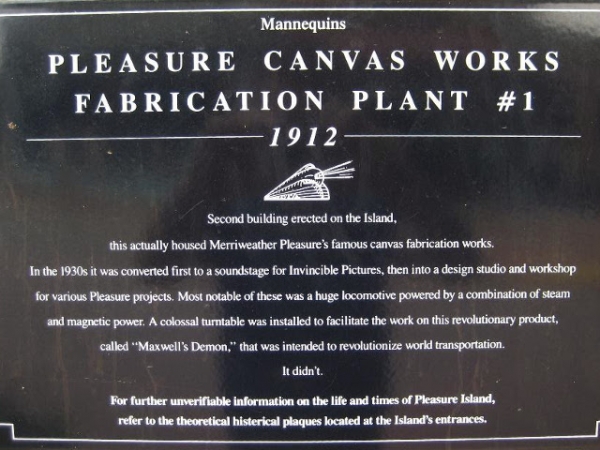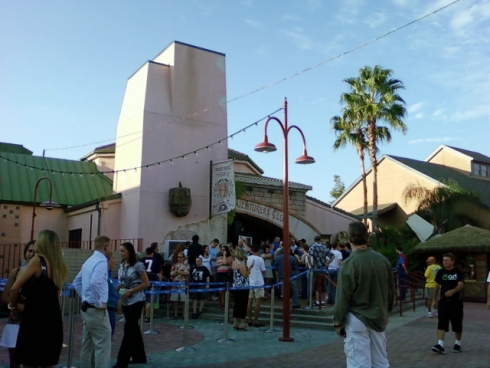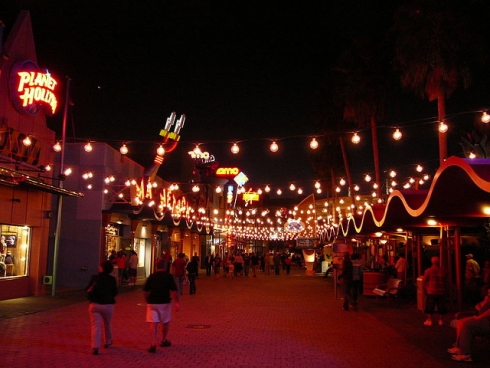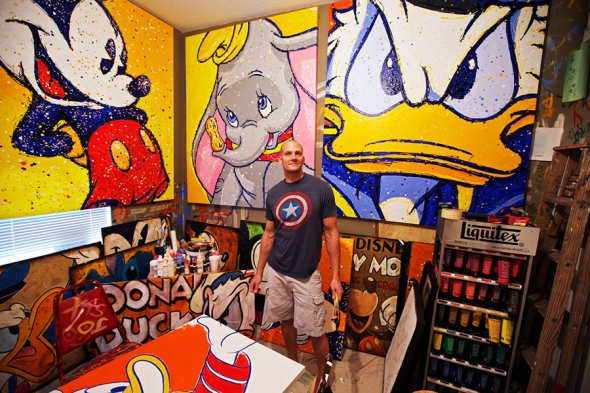I swear that I am not making up this name

Does the name Merriweather Adam Pleasure mean anything to you? Hopefully, the answer is no because even Disney superfans struggle with this one. Mr. Pleasure (or MAP, if we use his initials) is the fictional founder of Pleasure Island. Disney created this character in order to tie a theme the new version of the entertainment district. They no longer fixated on aesthetics at the expense of actual story, which was in reality a step back, something they wouldn’t recognize for too long.
While the village had a style all its own, Pleasure’s new “island” emphasized shopping with a bit of back story. And the weird back story was that in 1911, MAP bought himself a new plaything. It was an island. Bored during downtime from one of his many adventures as a member of the Society of Explorers and Adventurers (S.E.A.), the itinerant explorer put down roots in his new home. And, like a good megalomaniac, he named it after himself. This tidbit was critical to the development of Pleasure Island since its signature restaurant was The Adventurers Club.
This nightclub was singularly unique in the history of Disney, and it’s so revered by some that it’s worthy of a standalone discussion at some point. Somehow a hybrid of Jungle Cruise narration, improvisational comedy, Audio-Animatronics, and Rick’s Place in Casablanca, The Adventurers Club was the place to go for a great time at Pleasure Island from 1989 until Disney closed its doors in 2008. During the final few days of its existence, fans flocked to it similar to how attendance spiked at The Osborne Family Spectacle of Lights in 2016. They even held a couple of memorial tribute shows in the years after S.E.A. shuttered The Adventurers Club.

The theme of the nightclub tied into the overall theme of Pleasure Island, and that theme was fun. Of course, Imagineers thought it was Mr. Pleasure, who viewed the site as a place to relish in his “lifelong interest in the exotic, the experimental, and the unexplainable.” When the would-be entrepreneur arrived on the island, he potted to become rich by manufacturing sails. Only one problem existed. Sailing was a dying industry as the Wright Brothers had recently developed the power of flight. Pleasure should have gone bankrupt, but World War I saved him. Military navies needed sails, so a stupid idea became an insanely profitable one. Merriweather had cause for merriment.
The reason why new ownership was in place when The Adventurers Club opened was due to (hilarious) tragedy. Pleasure, the “Grand Funmeister” made the incorrect decision to explore Antarctica, a journey from which he never returned. His bumbling sons drove his estate into bankruptcy, and they lost Pleasure Island in 1955 when (the real) Hurricane Connie wiped out the (fictional) community, which is a dangerous theming for a Florida resort…but I digress.
With no money and a destroyed community, the sons of Pleasure (how is that not a band name?) gave up on their exotic real estate inheritance. It devolved from a hotbed of decadence to the proverbial deserted island until archeologists discovered the abandoned lands in 1987. Like any good archeologist would, they chose to build a shopping and entertainment district as a monument to the weirdness of Merriweather Adam Pleasure.
Simple pleasures

Disney theming is always the gold standard, but their decisions with Pleasure Island were universally daring. They wanted to add a sense of whimsy to the experience of visiting Walt Disney World. The former site of the village became a new kind of entertainment district, one that prioritized parallels between the fictional themes and the very real stores.
Disney even elevated the proceedings with a nightly fireworks show. They called it a celebration of New Year’s Eve, which somehow occurred every single night. If true, that would mean that Pleasure Island was open for about 5,500 years. Alas, it only felt that way to employees.
Innumerable former Pleasure Island employees are nodding their heads at this comment, but the festivities had their intended effect. Many theme park tourists grew passionate about the entertainment district. And people loved The Adventurers Club, arguably the most fun environment in the history of Lake Buena Vista Shopping Village/Pleasure/Island/Downtown Disney/Disney Springs.
The rest of the Merriweather Adam Pleasure theming wasn’t quite so overt. Sure, anyone reading all the plaques and signs could add up the clues, but what Disney really wanted from their shopping center was money. They decided that the best way to get it was to tie everything together via story tales. Unfortunately, history repeated itself as Pleasure Island expanded and changed. No shopping area will stay the same over 20 years, of course, but any alteration to a themed area causes ripple effects.
A few people knew the history of Videopolis East, Fireworks Factory, and Merriweather’s Market. When Pleasure Island swapped them out for 8Tracks, Motion, and Raglan Road Irish Pub, something was lost. Fireworks Factory was supposed to relay the ridiculous tale of MAP using a cigar to blow up a building (accidentally, of course). What that has to do with Irish cuisine is a mystery only Disney understands.
Videopolis East was perhaps the most egregious instance of adapting too much and caring too little about theming. In 1989, it started as a New Wave dance club, making it at least five years too late. Then, it switched to Cage, which was vaguely alternative with a bit of grunge thrown in. At least Disney had the timeline right there, adding it in 1990. Then, they switched 8Trax in 1994; it was themed as a Studio 54-ish dance club, with a blend of 1970s and 1980s music. With the benefit of hindsight, that would have been the perfect fit in *1989*. With three different themes in only five years, the place always struggled with a reputation as a cynical nightclub where Disney pandered to whatever they thought crowds wanted at the time.
Each time Disney changed something, Merriweather Adam Pleasure died a little bit more. Of course, it’s not that tragic since he never existed in the first place and also was kind of stupid to boot. A phantom moron as the primary theme of Pleasure Island speaks volumes about the flaws with the concept. Still, everyone who hung out at Pleasure Island generally had a great time. They were still at Walt Disney World, after all. And the company expressed satisfaction with the entertainment complex as long as guests continued to attend.
The change happened in the early 2000s. And it wasn’t Disney’s fault. The American economy took a turn and then the global economy grew sluggish, too. The prevailing opinion about Pleasure Island was that it was inferior to Universal CityWalk Orlando, an entertainment district a decade newer and with better anchor restaurants. Universal employed a different kind of theming, building anchor establishments for popular franchises like Margaritaville, Bubba Gump Shrimp Co., and Hard Rock Café. Despite the overwhelming charisma of Merriweather Adam Pleasure, many tourists stuck with the brands they knew rather than a flamboyant playboy adventurer.
Rebooting the reboot of the reboot (or something like that)
Image: Disney
By the time the housing market collapsed and the global economy dipped precipitously, Pleasure Island was doomed to a spot in the more frustrating annals of Disney history. Everyone agreed that the shopping center sold well and was a profoundly forward-thinking idea by Walt Disney. The execution of the shopping center was simply lacking. The erratic nature of updates to the village caused it to lose thematic integrity. It became gangly and unattractive over time. Then, Pleasure Island mixed the basics of restaurants and shopping with the outrageously eccentric and weird. Disney recognized that they have fans of each aspect of the experience, but finding a person who enjoyed all three was rare. And the cost of upkeep on the Pleasure Island nightlife caused problems, as did having a lot of drunks on the Walt Disney World campus.
With the economy in freefall and Pleasure Island perceived as failing, Disney rebooted again. Almost incomprehensibly, they again prioritized theming. The story of the planned evolution of Pleasure Island into Hyperion Wharf is a tale for another day. Suffice to say that it was a placeholder for what came next. And that too was something with a theme. To Disney’s credit, however, they finally learned from past mistakes.
The current theme of the region once known as Lake Buena Vista Shopping Village is…water. Technically, it is springs. Landscapers tasked with finding a more solidifying tie for the various areas of the former Downtown Disney sold their bosses on an obvious solution. The entire community was originally built with a natural centerpiece: a body of water that the original Imagineers carved out of land from Walt Disney’s beloved Florida Project. By embracing the heritage of the land, they could augment and honor the legacy of their founder. Sometimes, the clearest solution is also the best one.
Disney Springs is the culmination of more than 40 years of attempts at perfecting the primary entertainment complex at Walt Disney World. Fittingly, The Walt Disney Company re-introduced their seminal entertainment industry in 1965, 50 years after Walt Disney himself looked at a map and said, “I don’t care how long it takes. We have to buy that land.” As always, he was right…and far ahead of his time with his strategy.


Comments
First, get an editor. This story rambled from one place to another, never making the point the headline of the story intended to.
Second, the conclusion of the story did match the headline in any way.
Third, the timeline was awful. Eighty percent of the story could have been called "Downtown Disney: A tale of Disney world's early years"
Try harder.
I remember going to "Disney Village" in the 80's and then Pleasure Island in my teenage years. I always found it odd that it had the same name as the "bad place" in Pinocchio where kids smoke cigars and turn into donkeys. That was a bit of weird unintended(?) synergy.
Great article but it seems only halfway done. Would love more insight into the different themed clubs of PI or it's transformation into Disney Springs and the rebooting of the story there.